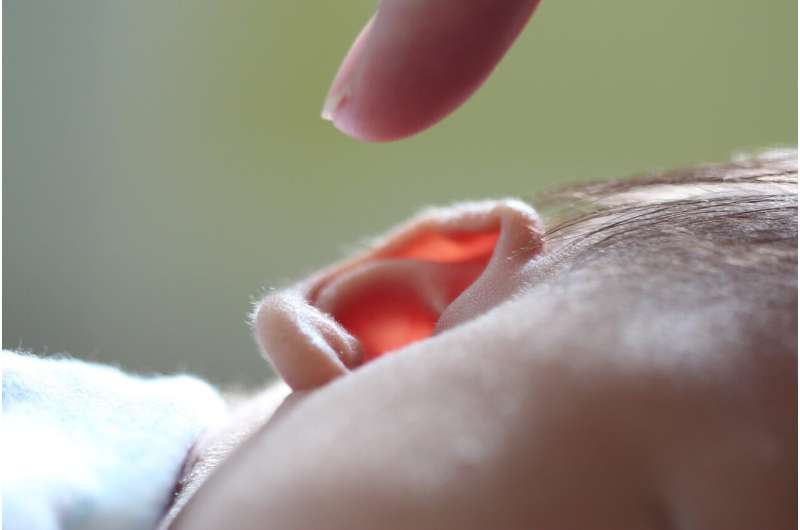Synthetic viral vector and surgical technique effectively deliver genetic cargo to inner ear in preclinical study

A synthetic viral vector and a novel surgical approach developed at Mass Eye and Ear has enabled efficient gene transfer into the inner ear of nonhuman primates, a research team working towards the development of effective treatments for hearing loss and vestibular disorders has reported.
In previous studies, the Mass Eye and Ear research team showed they were able to successfully target the inner ear and show therapeutic efficacy in mouse models. The new findings, published March 15 in Nature Communications, suggest that an adeno-associated virus (AAV) vector called Anc80L65 can be combined with a novel surgical approach, consisting of a transmastoid posterior tympanotomy, to deliver genes into the inner ear, which could provide a promising pathway for translating this research into humans.
“Hearing disorders affect millions of individuals and impede their ability to communicate, yet hardly any drug treatments are available to mitigate these conditions,” said study co-author Luk Vandenberghe, Ph.D., director of the Grousbeck Gene Therapy Center at Mass Eye and Ear and an associate professor of ophthalmology at Harvard Medical School. “Delivery to the cochlea is one of the greatest challenges. Here, we show the potential of a one-time surgical intervention of a durable gene-based drug platform to eventually change the status quo for patients.”
Hearing loss, a global epidemic that remains untreated
Hearing loss affects more than 400 million people worldwide. The most common type of hearing loss is called sensorineural hearing loss, which typically originates from damage to the delicate structures within the inner ear and the destruction of hair cells responsible for hearing. More than half of all childhood deafness cases are genetic and caused by mutations in over 120 different genes, fueling the need for a gene therapy solution. Vestibular, or balance, disorders can also originate in the inner ear and can be treated with such an approach.
In an effort to reach the inner ear, the researchers devised a surgical method to delicately gain access to what’s known as the round window membrane, which is an opening from the middle ear into the inner ear. Once inside the inner ear, the gene therapy is delivered via a viral vector. This approach was inspired by cochlear implant surgery, which similarly requires access to the inner ear.
The novel surgical method was developed by Konstantina Stankovic, MD, Ph.D., Bertarelli Foundation Professor and Chair of the Department of Otolaryngology–Head and Neck Surgery at Stanford University School of Medicine and Michael McKenna, MD, co-founder and Chief Medical Officer at Akouos. Both are former chiefs of the Division of Otology and Neurotology at Mass Eye and Ear and faculty members at Harvard Medical School, where they developed this surgical method.
The vector that transfers the gene therapy into the inner ear is called Anc80L65, which is an AAV first created in the laboratory of Dr. Vandenberghe and was previously shown in mouse studies to be a potent gene transfer vector to several organs.
Efficient and feasible gene transfer to inner ear
The inner ear is a pristine space with many intricate structures, which means invasive surgeries should be kept to a minimum. Gene therapy is beneficial since it is a single treatment that requires one surgery.
The AAV-surgical approach is comparable to what is used in approved and experimental gene therapies at Mass Eye and Ear for treating disorders of the eye’s retina. During these therapies, a surgical procedure takes place before a gene therapy is injected into the eye.
In the new study, researchers tested how effective two AAV technologies—AAV1, an established vector for use in the cochlea, and the synthetic Anc80L65—were at targeting the inner hair cells, the primary sensors of sound in the ear. The surgical and molecular aspects of the delivery to the inner ear were found safe and well tolerated, which the authors say opens the door for future human applications. Anc80L65 in two animals transduced up to 90 percent of inner hair cells; AAV1 was markedly less efficient at equal dose. AAV neutralizing antibodies were detected in serum but not in cerebrospinal fluid following injection in all animals, indicating the gene therapy went to its intended target.
The results reveal that Anc80L65 can be delivered into the inner ear, and consistently transduce cochlear and vestibular cells of young nonhuman primates using an optimized surgical approach that allows visualization of the round window prior to injection of the gene therapy.
“Hearing loss is the most common sensory deficit across the globe, and at least half of congenital hearing loss is attributable to genetic causes. Thus, the potential of gene therapy is transformative,” said Dr. Stankovic. “This research demonstrates the feasibility of using a genetic and surgical approach to target specific cells in the inner ear of non-human primates. If translated into successful therapies for humans, the impact will be enormous, similar to the way in which gene therapy has ameliorated other disorders such as blindness.”
Developing treatments for incurable disorders
Studies that utilize this surgical approach and AAV to test gene therapies are ongoing for some of the specific genes leading to hearing loss in animal models, with the hopes of one day translating this research into treatments for humans. The technology is being studied to not only add genes but knock out genes that are toxic to hair cells.
Source: Read Full Article
